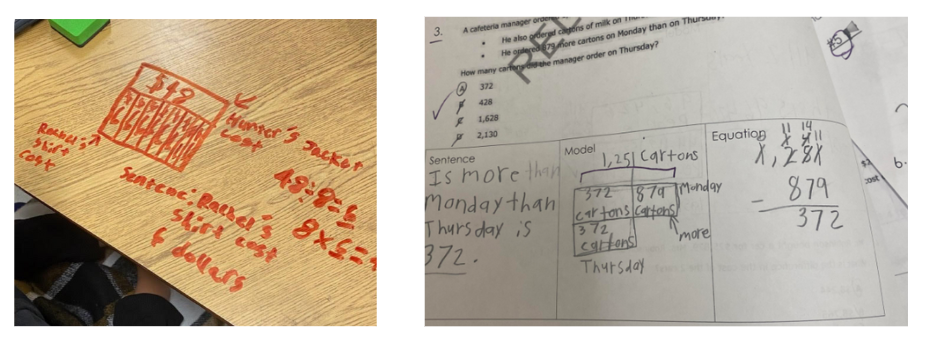December 13, 2023
I’ve talked to you a lot about Structures of Equality (SoE), a reading comprehension tool to help your students understand and solve word problems.
But I wanted you to have the opportunity to hear from someone else in the trenches. After a professional development workshop this past summer, I’ve kept up with a teacher who decided to go all in. I asked her if I could interview her so other teachers could hear from someone else who gets it AND for teachers who haven’t yet implemented it to understand the process, the struggles, and the eventual payoffs.
Meet Jasmin Nabors, a 4th grade teacher in Durham, NC. She’ll share her struggles, successes, and a few tips.
Before implementing the use of SoE, Jasmin used different strategies to help students solve word problems like bar models and arrays, but wasn’t consistent with these from year to year. She was kind enough to share her time with us.
The Initial Challenges
Me: What were some of the biggest challenges you were facing in your math class when it came to your students solving word problems?
Jasmin: It was really difficult for the kids to even read the text. The kids were number pullers.
And it went beyond decoding. Even when she read the problems aloud, the kids struggled with comprehension skills such as understanding what the question itself was asking. They couldn’t identify question words, and with many students who are Multilingual Learners (MLL), general vocabulary was a challenge.
Choosing Structures of Equality
Me: Why did you decide to try SoE in your classroom?
Jasmin: I really wanted to hold myself accountable to do something that I know would have a really strong impact and push myself to not cave to just do the algorithm model.
Jasmin knew it wasn’t going to have a magical effect, but she knew she needed to try something different. She wanted to level the playing field and help her students access math conceptually.
Instructional Shifts: Deeper Questioning
Me: What shifts did you have to make to your instruction using SoE as a comprehension tool?
Jasmin: Before, I would always ask “What do you know?” But I don’t feel like that worked. Now, using your structures, I ask questions like “ What’s the action?” and “What’s the main idea?” I ask breaking down kinds of questions that really help the kids.
Success Stories
It’s still too early in the year to have data to quantify her success, but she has plenty of anecdotal evidence. If you’re curious about data from other classrooms, you’ll love this class-by-class comparison.
Me: What changes have you noticed in your students?
This is where Jasmin got really animated. You could see how proud she was of the things her kids were doing. Rather than share her answer verbatim, here are a few highlights:
- She has a student working on 1st-grade reading skills. But she’s “blowing it out of the water” in math because she has the scaffolds of the structures to support her.
- There’s a student in her class who is “good at math” because he’s had success with the algorithm. But he didn’t necessarily understand the math. He couldn’t explain his thinking. Now she’s seeing precision in his work and he’s engaging in conversations around ideas like unit and value.
- Two students were both unsure of themselves and would get lost in the words. Now they’re problem-solving, being more attentive to their work, and asking questions to help them understand the word problems.

Me: Have you had any pushback? What are the overall feelings of your kids’ caregivers?
Jasmin: They appreciate the work we do. They noticed their kids slowing down and organizing their work. They’re thinking about what they’re solving.
It hasn’t been an easy road, but it’s been one worth traveling. There are still times Jasmin gets frustrated but she won’t give up. It takes a lot of effort and hard work but it’s worth the output.
Jasmin’s insights: tips for successful implementation
- Work out the models before you teach them.
- Try it with your colleagues.
It takes time to internalize the structures. Before you solve problems with your class, work through the structures on your own. This will help you anticipate misconceptions and make your class run more smoothly.
She was also fortunate that the other teachers on her grade level were willing to take the leap with her. They could bounce ideas off each other and share their struggles along with their successes.
Conclusion
Jasmin’s adventure has been filled with ups and downs. But as she tackles each new challenge that arises and sees the transformation in her students, she knows that SoE is here to stay in her classroom. Her goal is to make her classroom a place where every student can thrive. Are you ready to join her? If you’re new to SoE, you can start here.
My email subscribers have exclusive access to the chance to win a free, virtual, personalized 1-hour workshop with me (December 2023 only). Want in? Join my mailing list and I’ll land in your inbox every Sunday morning.